Ready to transform your garden into a thriving paradise? Start with marigolds in spring for pest protection and zinnias to attract bees! In summer, pair tomatoes with basil for flavor and protection. Autumn calls for kale and carrots, working together to enrich your soil. Even in winter, kale and garlic can thrive beneath frost! Each plant plays its role in this lively dance! So, stick around, and you might just discover the secrets of successful companion planting!
Spring Companion Planting Strategies
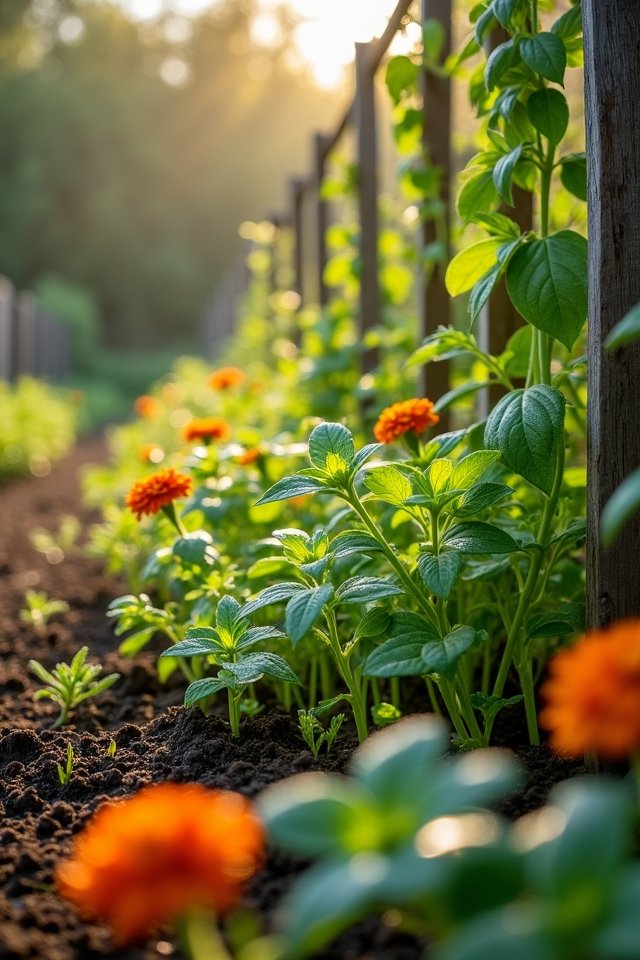
As spring bursts forth with blooms and sunshine, it’s the perfect time to immerse yourself in companion planting strategies that can transform your garden into a vibrant oasis! Imagine this: your spring flowers flourishing alongside bold marigolds, warding off those pesky pests, while attracting honeybees with their delightful colors. By planting basil near tomatoes, you not only enhance flavor, but also enjoy natural pest control! Think interconnected ecosystems—where every plant plays a role! Why not pair zinnias with your veggies? Their stunning blooms are like a party for beneficial insects! So, grab those seed packets, and get ready to experiment! You’ll witness a thriving mini-ecosystem that not only looks gorgeous but also supports your plants’ health naturally.
Summer Planting Partnerships
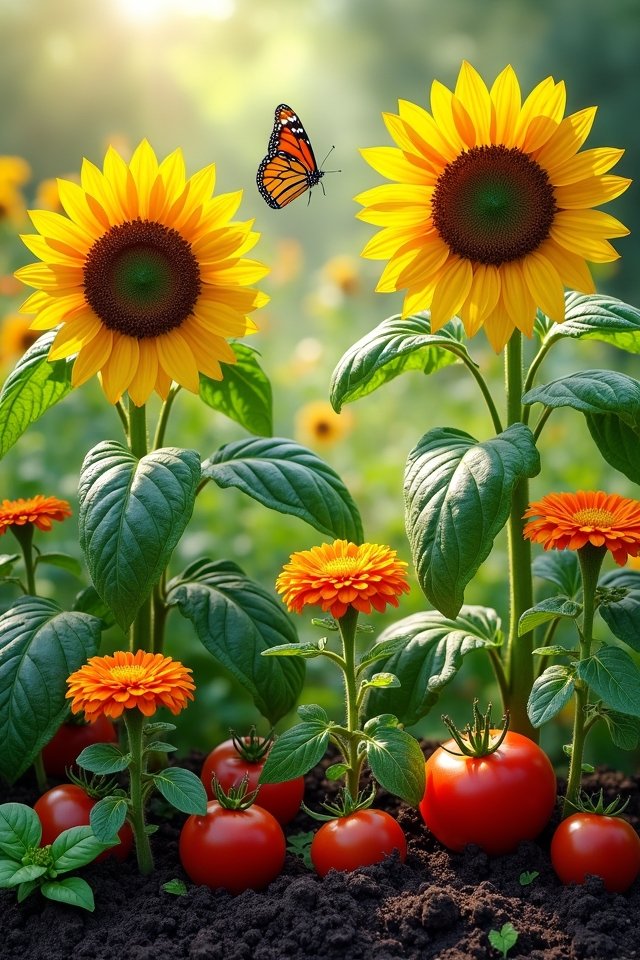
What’s more delightful than the vibrant colors and luscious aromas of a summer garden? Imagine freshly plucked tomatoes paired with fragrant basil, creating a culinary partnership that sparks joy in every dish! When you plant them together, you’ll not only enhance flavors but also deter pests—basically, a win-win!
On the other hand, consider the surprising duo of cucumbers and radishes. Radishes grow quickly and can help break up the soil, giving cucumbers a perfect space to thrive. Plus, their contrasting textures will catch the eye!
Fall Crop Combinations
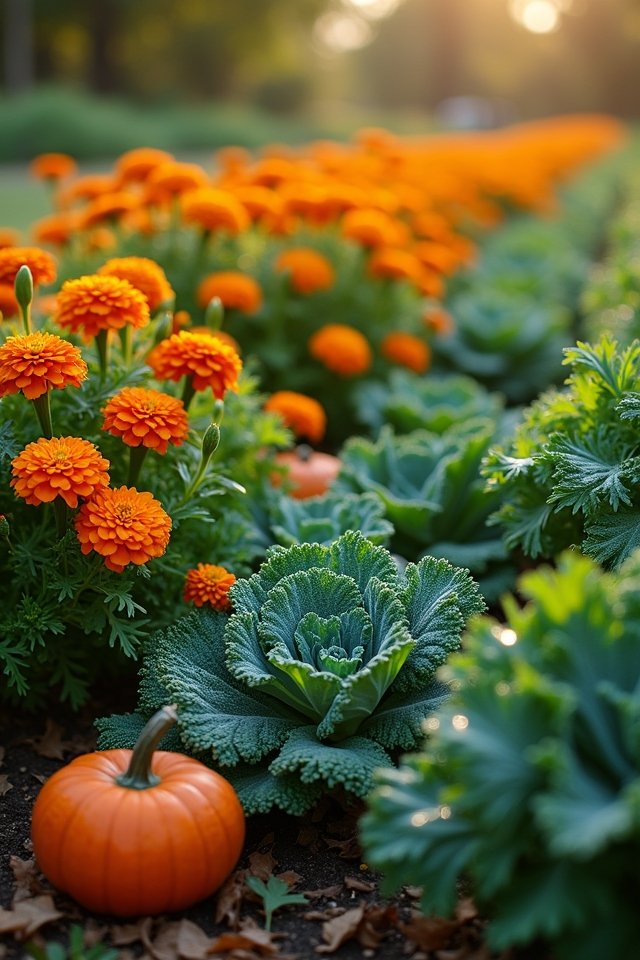
Even when summer bids farewell, your garden can still showcase a fabulous array of colors and flavors during the fall! Imagine crisp evenings filled with the scent of roasted root vegetables. Pair some vibrant kale with sweet carrots for a delightful fall vegetable pairing. They’ll thrive together, battling pests while enriching your soil!
Consider implementing autumn crop rotation—after harvesting cucumbers, swap them for hearty spinach. This boosts your soil’s nutrients while keeping your garden bustling and productive. Don’t forget to tuck in some marigolds; they deter pesky nematodes like tiny soldiers!
Winter Gardening and Companion Plants
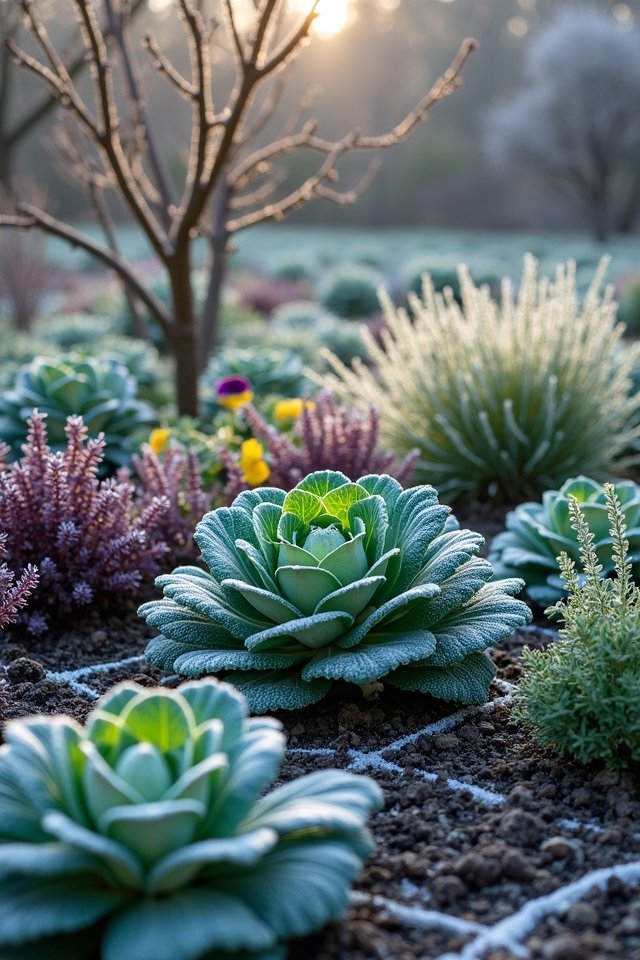
While winter might seem like a time for your garden to hibernate, it actually holds the promise of vibrant life! By growing winter vegetables, you can enjoy fresh produce even in the chilly months. But wait! Don’t forget about frost protection!
Picture your garden with:
- Crisp, leafy kale and Swiss chard, shimmering under a frost blanket.
- Bright orange carrots peeking through the snow, waiting for your enthusiastic harvest.
- Robust garlic, quietly thriving beneath the frosty surface, ready for spring feasts.
These companion plants get snug together, creating a tiny ecosystem. And how awesome is that? Winter gardening might just be your new favorite hobby! Why not welcome it and transform those frost-laden days into a lush, edible paradise?
Year-Round Companion Planting Benefits
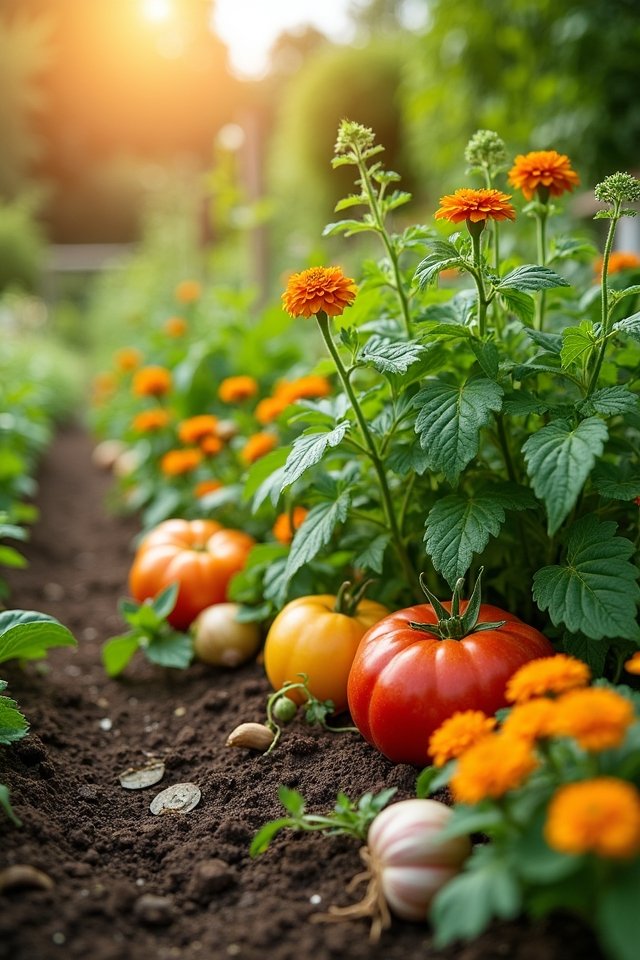
The beauty of year-round companion planting lies in its whimsical dance of harmony and life! By weaving together different plants, you engage in a powerful partnership that boosts soil health, creates an ecosystem, and even acts as brilliant pest control. Imagine lush basil nestled beside tomatoes, enhancing flavor while warding off pesky aphids!
You’re not just planting; you’re creating a living tapestry! Seasonal shifts reveal new benefits—like nurturing clover in winter to enrich the soil, or vibrant marigolds to repel unwanted bugs in summer. Each plant plays its role, much like a finely-tuned orchestra. So why not welcome this dynamic duo for every season? You’ll harvest bountiful crops while dancing through the seasons, one delightful plant at a time!
Frequently Asked Questions
What Are the Best Companion Plants for Pest Control?
Looking for the best companions to tackle pesky pests? Varieties like marigolds and nasturtiums work wonders in your garden! Marigolds not only add vibrant colors, but their scent also repels aphids and nematodes. Pair basil with tomatoes—talk about a delicious duo! This herb combo not only enhances flavor but also wards off harmful insects. So, why not let your plants team up for a pest-fighting fiesta? You’ll love the results!
How Do Companion Plants Improve Soil Health?
Companion plants are like your garden’s best friends, boosting soil health in brilliant ways! They attract beneficial insects and support soil microbes, creating a thriving community. Think of them as a lively potluck, where each plant brings tasty nutrients to the table. For instance, legumes fix nitrogen, enriching the soil, while deep-rooted plants break up compacted earth, improving nutrient cycling! Who knew gardening could feel like a joyous concert? Isn’t that exciting?
Can Companion Planting Attract Beneficial Insects?
Companion planting can be your garden’s best friend—like having a secret superhero squad! By planting flowers like dill or marigolds alongside your veggies, you attract beneficial insects, turning your garden into a buzzing paradise. These friendly insects, like ladybugs and lacewings, form beneficial relationships that protect your crops from pesky pests. Imagine your garden blooming with life, a vibrant tapestry where every plant plays its part. Isn’t that a delightful thought?
What Vegetables Should Not Be Planted Together?
You wouldn’t throw a party and invite your ex, right? Similarly, some veggies simply don’t mix well! For example, beans and onions are like oil and water—they clash, affecting crop compatibility. Watch out for tomatoes and corn too; they can cause plant relationships to go sour. Avoid these mismatches to guarantee your garden flourishes beautifully! Happy planting! You’re not just growing vegetables; you’re creating harmony in your garden!
How Can I Create a Companion Planting Journal?
Creating a companion planting journal can be a blast! Start with a colorful binder, adding sections for different planting techniques, like herbs with veggies or flowers alongside squashes. Organize entries by season, noting successful pairings or mishaps—think of it as your gardening adventure diary! Include sketches, photos, and even doodles. You’ll love flipping through the pages, reliving your garden glory! Wanna know what works best with tomatoes? Immerse yourself and discover!


